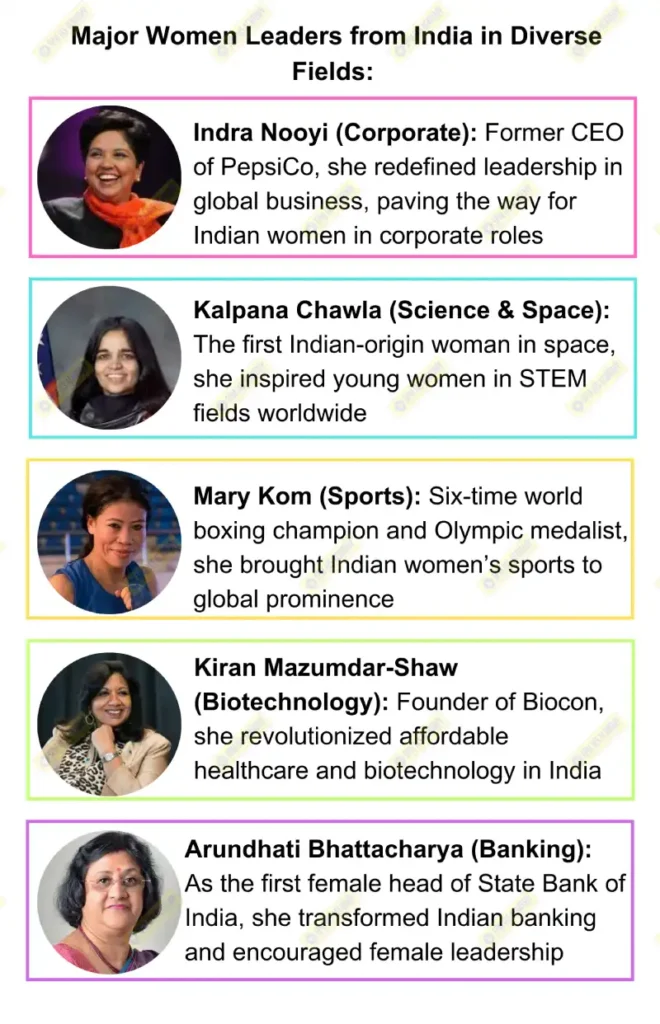Indian women represent a significant portion of the population and have immense potential to contribute to the country’s economic and social development. While progress has been made in various areas, women remain an underutilized resource in key sectors of the economy and public life. However, there are also areas where Indian women have made substantial strides, challenging the view that they are entirely untapped.
Indian Women as an Untapped Human Resource
1. Low Workforce Participation:
- Despite women constituting nearly 48% of India’s population, their participation in the labor force remains critically low. The Periodic Labour Force Survey (PLFS) 2021-22 indicates that the female labor force participation rate (FLFPR) is around 25%, far below the global average of 47%.
- Kristalina Georgieva, Managing Director of the IMF, stated, “If women’s participation in the workforce were equal to men’s, India’s GDP could rise by 27%.” This highlights the economic potential of women if systemic barriers are addressed.
2. Barriers to Workforce Engagement:
- Social norms, gender roles, and the lack of childcare facilities often prevent women from entering or staying in the workforce. This reflects a vast underutilization of their potential in sectors such as STEM, corporate leadership, and entrepreneurship.
- Only around 10% of leadership positions in Indian businesses are held by women, as per the World Economic Forum (WEF) Gender Gap Report, 2023. These barriers highlight the untapped potential of women in decision-making roles.
3. Entrepreneurship and the Informal Sector:
- Indian women dominate the informal economy but are underrepresented in formal sectors. Initiatives like Self-Help Groups (SHGs) and schemes such as Mudra Yojana have empowered women, with over 70% of the loans disbursed to female entrepreneurs. However, women still face challenges such as limited access to credit and skills training, leaving much of their potential untapped.
- Kiran Mazumdar-Shaw, chairperson of Biocon, emphasizes, “Women must be recognized not just for their potential but for their ability to drive growth, especially in the entrepreneurial space.
4. Gender Gaps in Education and Skills:
- Although literacy rates for women have improved from 8.9% in 1951 to over 70% in 2021, significant gaps remain in higher education and technical fields. Women’s participation in STEM is particularly low, with fewer women pursuing engineering and technology courses.
- Programs like Beti Bachao Beti Padhao have helped raise awareness about the importance of education, but bridging the gap in skill development is essential to make women a more integrated part of the workforce.
Areas Where Indian Women Have Made Significant Progress
1. Political Participation:
- Indian women are increasingly involved in politics and governance. India has seen women hold positions such as President, Prime Minister, Chief Ministers, and Members of Parliament. The 73rd Constitutional Amendment has ensured 33% reservation for women in Panchayati Raj Institutions, enhancing their role in local governance.
- Leaders like Nirmala Sitharaman, the current Finance Minister, and Sushma Swaraj, a former External Affairs Minister, are examples of how women are breaking barriers in high-level decision-making roles.
2. Corporate Leadership:
- Indian women have also made significant strides in the corporate sector. Indra Nooyi (former CEO of PepsiCo) and Suneeta Reddy (Managing Director of Apollo Hospitals) are examples of women leading global and national businesses. Although representation at the top remains low, it’s evident that women are slowly breaking through the glass ceiling.
- Nirmala Sitharaman has stated, “Women’s leadership is not about tokenism but about the meaningful contribution they bring to the table.”
3. Social Reform and Advocacy:
- Women have been at the forefront of social reforms and movements in India, such as fighting for gender rights, environmental justice, and human rights. Initiatives led by activists like Aruna Roy and movements like MeToo have been instrumental in advancing women’s rights and addressing issues of workplace harassment and gender-based violence.
4. Education and Health Improvements:
- The improvement in education and maternal health indicators over the last few decades has empowered women to play a greater role in their communities. Maternal mortality rates (MMR) have significantly dropped to 97 per 100,000 live births in 2020, reflecting improvements in health services.
- Women’s enrollment in higher education has also been rising, with the Gross Enrollment Ratio (GER) for females surpassing that of males in many states. These developments show that Indian women are increasingly stepping up in fields that were traditionally male-dominated.
While Indian women have made significant gains in areas like politics, education, and entrepreneurship, they remain a largely untapped human resource due to the low labor force participation, social barriers, and limited access to opportunities in critical sectors. As Prime Minister Narendra Modi emphasized, “Women-led development is crucial for India’s growth story.” Unlocking the full potential of Indian women requires focused efforts on skill development, education, and equal access to the labor market, making them essential drivers of India’s future progress.












